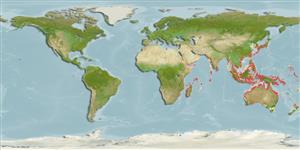分类 / Names
俗名 | 同种异名 | Catalog of Fishes(属, 种) | ITIS | CoL | WoRMS | Cloffa
Environment: milieu / climate zone / 深度上下限 / distribution range
生态学
海洋; 半咸淡水 礁区鱼类; 深度上下限 2 - 20 m (Ref. 90102). 熱帶
Indo-West Pacific: western India to Indonesia; south to northwestern Australia.
印度-西太平洋: 印度到印尼西部; 南至澳洲西北部。
大小 / 重量 / 年龄
成熟度: Lm ? range ? - ? cm
Max length : 35.0 cm TL 雄鱼/尚未辨别雌雄; (Ref. 9710)
简单描述
检索表 | 型态特徵 | 形态测量图
背棘 (总数) : 1; 背的软条 (总数) : 48 - 50; 臀鳍软条: 58 - 62.
Body shape (shape guide): elongated.
Inhabits sandy weedy areas of coastal reefs (Ref. 9710). Lives in open muddy substrates in estuaries as well as deep coastal bays. Usually found lining up with ropes, seawhips and large stringy-type sponges. Incredible mimic that may float over the open bottom like a mangrove-shoot, may stand on its head (Ref. 48637). Enters mangroves (Ref. 9710).
栖息于岸礁的沙杂草丛生区域。 (参考文献 9710) 在河口生活在开放的泥质底部以及深的近岸海湾。 以粗绳, 海鞭子与大的线-类型海绵通常发现于衬里增加。 难以置信的拟态以可能遍及开放的底部飘浮类似一个红树林-射击, 可能站在它的头部.(参考文献 48637) 进入红树林。 (参考文献 9710)
Life cycle and mating behavior
成熟度 | 繁殖 | 产卵场 | 卵 | 孕卵数 | 仔鱼
印度-西太平洋: 印度到印尼西部; 南至澳洲西北部。
Allen, G.R. and R. Swainston, 1988. The marine fishes of north-western Australia: a field guide for anglers and divers. Western Australian Museum, Perth. 201 p. (Ref. 3132)
世界自然保护联盟红皮书 (Ref. 130435: Version 2025-1)
人类利用
渔业: 低经济
工具
特别资料
下载 XML
网络资源
Estimates based on models
Preferred temperature (参考文献
123201): 24.7 - 29.3, mean 28.5 °C (based on 3053 cells).
Phylogenetic diversity index (参考文献
82804): PD
50 = 1.0000 [Uniqueness, from 0.5 = low to 2.0 = high].
Bayesian length-weight: a=0.00589 (0.00231 - 0.01499), b=3.07 (2.85 - 3.29), in cm total length, based on LWR estimates for this (Sub)family-body shape (Ref.
93245).
营养阶层 (参考文献
69278): 2.8 ±0.4 se; based on size and trophs of closest relatives
回复力 (参考文献
120179): 中等的, 族群倍增时间最少 1.4 - 4.4年 (Preliminary K or Fecundity.).
Fishing Vulnerability (Ref.
59153): Low vulnerability (25 of 100).
🛈
Nutrients (Ref.
124155): Calcium = 47.1 [18.6, 116.0] mg/100g; Iron = 0.592 [0.262, 1.338] mg/100g; Protein = 18.2 [16.1, 20.6] %; Omega3 = 0.08 [0.03, 0.17] g/100g; Selenium = 30.1 [13.7, 69.2] μg/100g; VitaminA = 73 [25, 213] μg/100g; Zinc = 1.74 [1.12, 2.75] mg/100g (wet weight);
